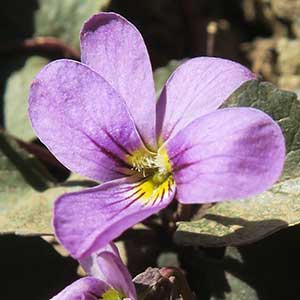Viola pinetorum
Viola flettii
goosefoot yellow violet, mountain yellow violet, pine violet
Flett's violet, Olympic violet, rock violet
1–3, prostrate or erect, leafy proximally and distally, puberulent or canescent to gray-tomentose, sometimes glabrous, on caudex from subligneous rhizome.
1–3, ascending to erect, mostly glabrous, on caudex from fleshy rhizome.
basal and cauline;
basal: 1–4;
stipules adnate to petiole forming 2 linear-lanceolate wings, margins entire or laciniate, apex of each wing free, tips usually filamentous;
petiole 2.3–9.5 cm, puberulent or canescent;
blade purple-tinted abaxially or not, usually linear to narrowly lanceolate, oblanceolate or obovate, or lanceolate-elliptic, rarely ovate, 1.3–5 × 0.3–2.5 cm, base attenuate, margins usually lacerate, dentate, or serrate, sometimes entire, usually undulate, ciliate, apex acute, mucronulate, surfaces puberulent to canescent or gray-tomentose;
cauline similar to basal except: stipules lanceolate, oblanceolate, or linear-oblong, margins entire or lacerate, apex acute to acuminate;
petiole 0.9–8.3 cm;
blade 2.8–9.6 × 0.3–1.4 cm, length 4–11 times width.
basal and cauline;
basal: 1–3;
stipules linear-lanceolate, margins entire or with glandular processes, apex acuminate;
petiole 1.5–9.7 cm, mostly glabrous;
blade purple-tinted and –veined, broadly reniform to ovate, 0.9–2.4 × 1.2–4 cm, base cordate, margins finely crenate-serrate, eciliate, apex acute to obtuse, surfaces glabrous or sparsely pubescent along veins adaxially;
cauline similar to basal except: stipules ovate to lanceolate, margins entire or shallowly laciniate;
petiole 0.7–5.9 cm, usually glabrous;
blade 0.8–2.1 × 1.2–3.1 cm.
2.9–11.5 cm, puberulent or canescent.
1.8–7.1 cm, usually glabrous.
sepals lanceolate, margins ciliate, auricles 0.5–1 mm;
petals deep lemon-yellow adaxially, upper 2 red- to purple-brown abaxially, lower 3 dark brown-veined, lateral 2 bearded, lowest 5–12 mm, spur color same as petals, gibbous, 1.5–3 mm;
style head bearded; cleistogamous flowers axillary.
sepals lanceolate, margins eciliate, auricles 0.5–1.5 mm;
petals soft reddish violet on both surfaces, all with yellow area basally, lower 3 dark violet-veined, lateral 2 bearded, lowest with white around yellow area, 10–15 mm, spur yellow, gibbous, 0.5–2 mm;
style head bearded; cleistogamous flowers axillary.
ovoid, 3.5–7 mm, puberulent.
± spherical, 5–9 mm, glabrous.
medium to dark brown, 2–3.5 mm.
dark brown to brownish purple, 2.5–3 mm.
= 12.
Viola pinetorum
Viola flettii
Flowers of Viola pinetorum have been observed to close up in late afternoon then fully reopen the following morning.
Although E. O. Wooton and P. C. Standley (1915) reported Viola pinetorum from New Mexico, the plant was probably V. nuttallii. K. W. Allred (2008) noted that V. pinetorum occurs in California; he did not recognize it in New Mexico.
Varieties 2 (2 in the flora).
(Discussion copyrighted by Flora of North America; reprinted with permission.)
Viola flettii is endemic to the Olympic Mountains of northwestern Washington. C. S. McCreary (2005) noted that although morphologically and ecologically distinct, V. cuneata, V. flettii, and V. ocellata are closely related.
(Discussion copyrighted by Flora of North America; reprinted with permission.)
1. Plants 6.5–18 cm, not cespitose; basal leaf blades 0.7–2.5 cm wide, surfaces puberulent; peduncles 3.4–11.5 cm. | var. pinetorum |
1. Plants 3–7(–9) cm, usually cespitose; basal leaf blades 0.3–1 cm wide, surfaces canescent, sometimes appearing gray-tomentose; peduncles 2.9–6(–7) cm. | var. grisea |


